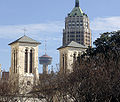Top Qs
Timeline
Chat
Perspective
Tower Life Building
United States historic place From Wikipedia, the free encyclopedia
Remove ads
Tower Life Building (formerly Smith-Young Tower, Pan-American Tower, and Transit Tower) is a 31-story building and a historical landmark in Downtown San Antonio, Texas, USA. Completed in 1929 and standing at 404 feet (123 m) tall, Tower Life Building was the tallest building and structure in San Antonio until the Tower of the Americas was completed in 1968, and the Marriott Rivercenter surpassed it as the tallest building in San Antonio in 1988. As of 2023, Tower Life Building is the 4th tallest building in San Antonio and the tallest eight-sided structure in the United States.
Designed by noted local architectural firm Ayres & Ayres (Atlee & Robert M. Ayres),[1] the neo-gothic tower has a brick and terra-cotta octagonal exterior, featuring gothic elements (such as grotesques, often misidentified as gargoyles) and an iconic green roof of Ludowici tile. The internal structure is reinforced concrete on the lower floors, and steel frame on the upper floors.
A television transmission antenna topped the tower from 1953 until 2010, when the tower reverted to the original design of a copper tophouse with a 114 ft (35 m) tall flagpole. In 1991 the building was placed on the National Register of Historic Places.[2]
After 78 years of ownership by the H. B. Zachry Family, the building was purchased in May 2022 by an ownership group composed of San Antonio developers Ed Cross, Jon Wiegand, and McCombs Enterprises. This ownership group plans to usher in new era for the building as a residence with 244 units for rent, expected to be completed in 2026.[3]
Remove ads
Greater 1920s Development
Originally known as Smith-Young Tower, the tower was the central component of a partially completed 1920s development called the Bowen Island Skyscrapers. The other completed building in the development is the former Plaza Hotel (also designed by Ayres & Ayres and opened in 1927), which became the local outlet of Hilton Hotels in 1956 and was converted into the Granada Apartments in 1966. Subsequent structures in the development were never built as a direct result of the Stock Market Crash of 1929 and the Great Depression.
Remove ads
Sears, Roebuck & Company
Summarize
Perspective
The tower housed San Antonio's first Sears, Roebuck & Company store, originally occupying the building's basement and first 4 levels.[4] Opening on March 7, 1929, Sears, Roebuck & Co. was the first portion of the building opened to the public, with 35,000 items on display and 225 members of staff.[4]
A famous purchase at this Sears, Roebuck & Co. took place on Nov. 17, 1934 when San Antonio Postmaster Dan Quill purchased multiple wedding rings from the jewelry counter on behalf of his friend Lyndon Baines Johnson, who was getting married later that day. Uncertain of the size, 12 wedding rings were purchased, with the one fitting Lady Bird Johnson's finger – and ultimately being selected – costing $2.98.[5]
| Basement | Heavy Merchandise and Cross Section
|
| Street Level |
|
| Floor 2 | Women's and Infants
|
| Floor 3 | Household Furnishings
|
| Floor 4 | Sears, Roebuck & Co. Administrative Offices and Reserve Stock |
Remove ads
Names through Time
When Smith-Young Tower emerged from receivership under a new owner (Dallas Rupe & Son., Inc.) in the mid-1930s, a competition was held for newspaper readers to write in with suggestions of a new name for the tower. The winning entry was submitted by school teachers Mr. & Mrs. Howard Doolittle, and the tower's name was changed to Pan-American Tower in 1938.[6] In 1942, the building was renamed Transit Tower for the San Antonio Transit Company, which was purchased by Dallas Rupe & Son., Inc. and had its headquarters in the building.[7] On Dec. 15, 1943, the tower was acquired by Citizens Republic Life Insurance company. In 1960, the insurance company announced it would change its name to Tower Life Insurance company, and the name of the building would change to Tower Life Building.[8]
Popular Culture
Film
Tower Life Building's exterior is featured prominently in the 1984 movie Cloak & Dagger. The building also appears in the background of scenes in the 2000 movie Miss Congeniality.
Television
- The tower has been a fixture on evening news backdrops.[specify]
- The tower was featured in the Docuseries Life After People in the episode titled "Roads to Nowhere" where the building collapsed 50 years after people.
Remove ads
Myths
Contrary to frequently-repeated stories along the River Walk, neither of the initial owners (Jim Smith nor Albert Smith) ended their lives by jumping from the tower during the Great Depression.[9]
Images
- Tower Life Building as viewed from the River Walk
- The building is seen in the background to the right, behind the San Fernando Cathedral.
- Viewed from the top of the Tower of the Americas in 2003.
See also
References
Bibliography
Wikiwand - on
Seamless Wikipedia browsing. On steroids.
Remove ads








